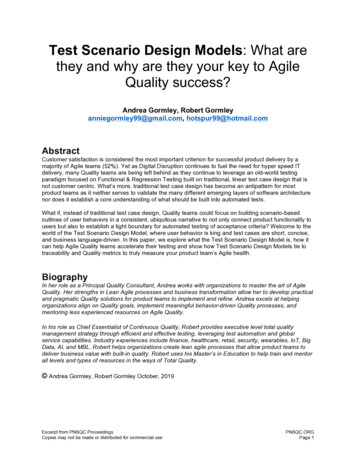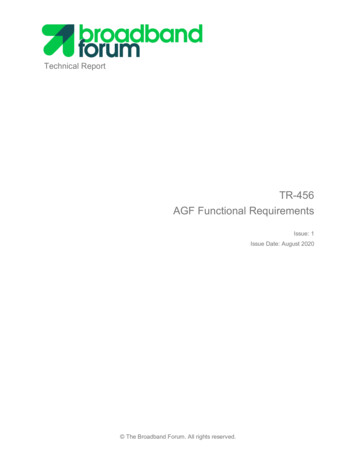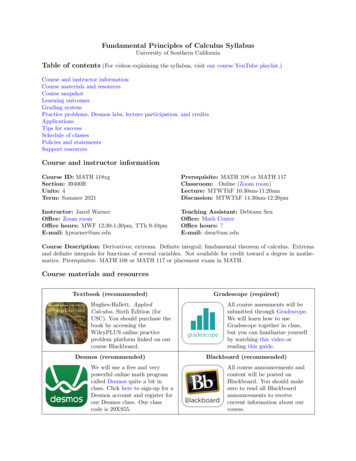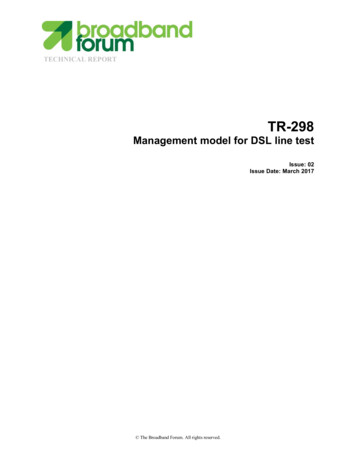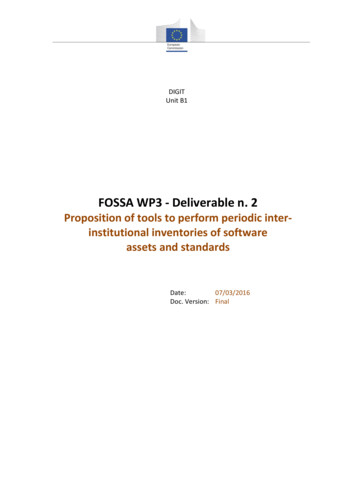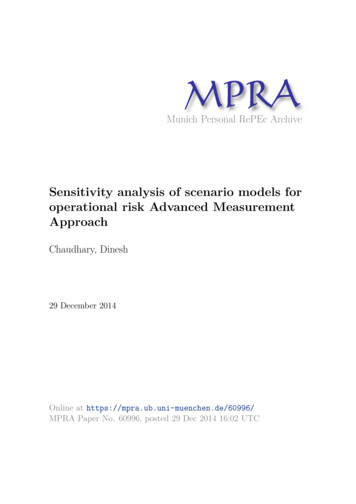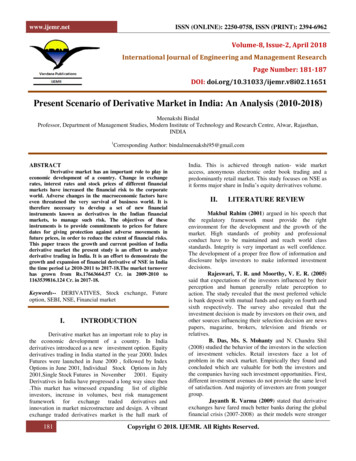
Transcription
www.ijemr.netISSN (ONLINE): 2250-0758, ISSN (PRINT): 2394-6962Volume-8, Issue-2, April 2018International Journal of Engineering and Management ResearchPage Number: 181-187DOI: doi.org/10.31033/ijemr.v8i02.11651Present Scenario of Derivative Market in India: An Analysis (2010-2018)Meenakshi BindalProfessor, Department of Management Studies, Modern Institute of Technology and Research Centre, Alwar, Rajasthan,INDIA1Corresponding Author: bindalmeenakshi95@gmail.comABSTRACTDerivative market has an important role to play ineconomic development of a country. Change in exchangerates, interest rates and stock prices of different financialmarkets have increased the financial risk to the corporateworld. Adverse changes in the macroeconomic factors haveeven threatened the very survival of business world. It istherefore necessary to develop a set of new financialinstruments known as derivatives in the Indian financialmarkets, to manage such risk. The objectives of theseinstruments is to provide commitments to prices for futuredates for giving protection against adverse movements infuture prices, in order to reduce the extent of financial risks.This paper traces the growth and current position of Indiaderivative market the present study is an effort to analyzederivative trading in India. It is an effort to demonstrate thegrowth and expansion of financial derivative of NSE in Indiathe time period i,e 2010-2011 to 2017-18.The market turnoverhas grown from Rs.17663664.57 Cr. in 2009-2010 to1163539816.124 Cr. in 2017-18.Keywords-- DERIVATIVES, Stock exchange, Futureoption, SEBI, NSE, Financial marketI.INTRODUCTIONDerivative market has an important role to play inthe economic development of a country. In Indiaderivatives introduced as a new investment option. Equityderivatives trading in India started in the year 2000. IndexFutures were launched in June 2000 , followed by IndexOptions in June 2001, Individual Stock Options in July2001,Single Stock Futures in November 2001. EquityDerivatives in India have progressed a long way since then.This market has witnessed expanding list of eligibleinvestors, increase in volumes, best risk managementframework for exchange traded derivatives andinnovation in market microstructure and design. A vibrantexchange traded derivatives market is the hall mark of181India. This is achieved through nation- wide marketaccess, anonymous electronic order book trading and apredominantly retail market. This study focuses on NSE asit forms major share in India’s equity derivatives volume.II.LITERATURE REVIEWMakbul Rahim (2001) argued in his speech thatthe regulatory framework must provide the rightenvironment for the development and the growth of themarket. High standards of probity and professionalconduct have to be maintained and reach world classstandards. Integrity is very important as well confidence.The development of a proper free flow of information anddisclosure helps investors to make informed investmentdecisions.Rajeswari, T. R. and Moorthy, V. E. R. (2005)said that expectations of the investors influenced by theirperception and human generally relate perception toaction. The study revealed that the most preferred vehicleis bank deposit with mutual funds and equity on fourth andsixth respectively. The survey also revealed that theinvestment decision is made by investors on their own, andother sources influencing their selection decision are newspapers, magazine, brokers, television and friends orrelatives.B. Das, Ms. S. Mohanty and N. Chandra Shil(2008) studied the behavior of the investors in the selectionof investment vehicles. Retail investors face a lot ofproblem in the stock market. Empirically they found andconcluded which are valuable for both the investors andthe companies having such investment opportunities. First,different investment avenues do not provide the same levelof satisfaction. And majority of investors are from youngergroup.Jayanth R. Varma (2009) stated that derivativeexchanges have fared much better banks during the globalfinancial crisis (2007-2008) as their models were strongerCopyright 2018. IJEMR. All Rights Reserved.
www.ijemr.netISSN (ONLINE): 2250-0758, ISSN (PRINT): 2394-6962and robust than the internal models of the banks. Therobustness should never be compromised for an increasedsophistication and calibration of the markets. The benefitsof Information Technology should be fully exploited tocover risk management. The exchange should not becomplacent on their margining systems and try toeliminate the elements that contribute towards the fragilityof the risk management systems.Mayank Raturi (2005) concluded that the valueof outstanding derivative contracts continues to expand,despite some setbacks due to the aftermath of the BaringBank and similar bankruptcies stories. Survival of CreditDerivatives was also questioned.III. OBJECTIVE OF THE STUDYTo analyze the current position of NSE in thederivative exchanges.To examine the growth of derivative market inIndia.To find out new opportunities in equity derivativemarket. IV.RESEARCH METHODOLOGYThe present study has been undertaken withempirical analysis of status of financial derivatives in Indiawith the use of secondary data. Data and information forthe research study were collected and analyzed fromsecondary published sources like newspapers, web sited,books etc.V.CONCEPT OF DERIVATIVESA derivative is a financial product which has beenderived from another financial product or commodity. Thederivatives do not have independent existence withoutunderlying product and market. Derivatives are contractswhich are written between two parties for easilymarketable assetsA Study of Derivatives Market in India.Derivatives are also known as deferred delivery ordeferred payment instruments. Since financial derivativescan be created by means of a mutual agreement, the typesof derivative products are limited only by imagination andso there is no definitive list of derivative products.A derivative is a financial product which has been derivedfrom another financial product or commodity.Definition of derivatives: The securities contracts(Regulation) Act 1956 defines “derivative” as undersection 2 (ac). As per this “Derivative” includes(a) “a security derived from a debt instrument, share, loanwhether secured or unsecured, risk instrument or contractfor differences or any other form of security.”182(b) “a contract which derived its value from the price, orindex of prices at underlying securities.”Participants in the derivative tradingHedgersDerivative products are used to hedge or reducetheir exposures to market variables such as interest rates,share values, bond prices, currency exchange rates andcommodity prices. This is done by corporations, investinginstitutions, banks and governments alike. A classicexample is the farmer who sells futures contracts to lockinto a price for delivering a crop on a future date. Thebuyer could be a food processing company, which wishesto fix a price for taking delivery of the crop in the future.Speculators/TradersDerivatives are well suited to trading on keymarket variables such as interest rates, stock marketindices and currency exchange rates and on prices ofcommodities and financial assets. It is much less expensiveto create a speculative position using derivatives than byactually trading the underlying commodity or asset. As aresult, the potential returns are much greater.A classic application is the trader who believes thatincreasing demand or scarce production is likely to boostthe price of the commodity. He has two options with him first option is to buy and store the physical commoditywhereas other option is to go long on futures contract.Trader chooses the second option to go long futurescontract on the underlying asset. If commodity priceincreases, the value of the contract will also rise and he canreverse back position to book his profit.ArbitrageursAn arbitrage is a deal that produces risk free profitsby exploiting a mispricing in the market. A simplearbitrage occurs when a trader purchases an asset cheaplyin one exchange and simultaneously arranges to sell it atanother exchange at a higher price. Such opportunities areunlikely to persist for very long, since arbitrageurs wouldrush in to buy the asset in the cheap location andsimultaneously sell at the expensive location, thusreducing the price gap.VI. APPLICATION OF FINANCIALDERIVATIVESRisk aversion tools: One of the most importantservices provided by the derivatives is to control, avoid,shift andmanage efficiently different types of risksthrough various strategies like hedging, arbitraging,spreading, etc. Derivatives assist the holders to shift ormodifysuitably therisk characteristics of theirportfolios. These are specifically useful in highly volatilefinancial market conditions like erratic trading, highlyflexible interest rates, volatile exchange rates andmonetary chaos.Prediction of future prices: Derivatives serve asbarometers of the future trends in prices which result in theCopyright 2018. IJEMR. All Rights Reserved.
www.ijemr.netISSN (ONLINE): 2250-0758, ISSN (PRINT): 2394-6962discovery of new prices both on the spot and futuresmarkets.Further, they help in disseminating differentinformation regarding thefutures markets trading ofvarious commodities and securities to the society whichenable to discoverer form suitable or correct or trueequilibrium prices in the markets. As a result, they assistin appropriate and superior allocation of resources in thesociety.Assist investors: Thederivatives assist theinvestors, traders and managers of large pools of funds todevise such strategies so that they may make proper assetallocation increase their yields andachieve otherinvestment goals.Catalyse growth of financial markets: Thederivatives trading encourage the competitive trading inthe markets, different risk taking preference of themarket operators likespeculators, hedgers, traders,arbitrageurs, etc. resulting i n increase in trading volume inthe country.Brings perfection in market: Complete marketconcept refers to that situation where no particularinvestors can be better off than others, or patterns ofreturns of all additional securities are spanned by thealready existing securities in it, or there is no furtherscope of additional security.Enhance liquidity: Asweseethat inderivatives trading no immediate full amount of thetransaction is required since most of them are based onmargin trading. As a result, large number of traders,speculators arbitrageurs operate in such markets. So,derivatives trading enhance liquidity and reducetrans-action costs in the markets for underlying assets.Classification of derivativeTypes of Derivatives in India Commodity Derivatives and financial derivatives Basic Derivatives and Complex Derivatives Exchange Traded Derivatives and OTC DerivativesCommodity Derivatives and financial derivativesDerivative contract are made into the differenttypes of commodities such as juts. Sugar, tea, oil. Thesederivative contracts are traded in commodity exchanges.The major commodity exchanges in India are three:183 National Commodity & Derivatives Exchange Limited(NCDEX) Multi- Commodity Exchange of India Limited (MCX) National Multi commodity Exchange of India Limited(NMCEIL)These exchanges provide different types ofcontracts (Which are called future contracts). Thederivatives in currencies gilt-edged debt securities, share,share indices, etc. are known as financial derivatives.These are traded at different exchanges all over the world.Financial derivatives can be broadly classified intocurrency derivatives, interest rate derivatives and stock andstock index derivatives. In India, stock future, stock IndexFutures, Stock Options and Stock Index Options are tradedat BSE OR NSE. Interest rate derivative have also beenallowed by the Government of India.Basic Derivatives and Complex Derivatives Basic Types: Those financial assets under whichunderlying assets are binding in an agreement by any oneof the contract I.e. Forwards , future, Options, warrants etc. Complex Derivatives: Those financial assets underwhich underlying assets are binding an agreement by theany one of the contract. Example Swap etc.Exchange Traded and OTC DerivativesDerivatives which are made and regulated by somemarket mechanism and trade on an exchange are calledexchange traded derivatives. Exchange traded derivativesare well standardized and organized in nature and availablein a well set financial or commodity market. Exchangetraded derivatives are available in NSE, BSE, NCDEX,MCX etc. All exchange traded derivatives can be financialor commodity derivatives and they are basedupon underlying assets such as stock, debt orforeign currency and different contracts which hasbasic of some underlying assets and designed totrade into exchange market I,e . Forwards,futures, options, warrant swaps etc. Any derivative contracts if traded outside theexchange market and privately negotiated arecalled over the counter contracts. Which is notbonded by rules and regulations of exchangemarkets. They offer customized products andwhich are very much tailor made in natureCopyright 2018. IJEMR. All Rights Reserved.
www.ijemr.netISSN (ONLINE): 2250-0758, ISSN (PRINT): 2394-6962Forwards: A forward contract is a customized contractbetween two entities, where settlement takes place on aspecific date in the future at today's pre agreed price.A forward contract is an agreement between twoparties to buy or sell an asset at a specified point of time inthe future. The price of the underlying instrument, inwhatever form, is paid before control of the instrumentchanges.Futures: A futures contract is an agreement between twoparties to buy or sell an asset at a certain time in the futureat a certain price. A futures contract is a financial contractobligating the buyer to purchase an asset, such as aphysical commodity or a financial instrument, at a predetermined future date and price, futures contracts detailthe quantity and quality of the underlying asset; they arestandardized to facilitate trading on a futures exchanges.Some future contracts may call for physical delivery of theasset, while others are settled in cash. The futures marketsare characterized by the ability to use very high leveragerelative to stock markets.Examples of international futures contracts are Corn future(CBOT) Gold future(COMEX) Crude oil futures (NYMEX) Stock index futures(CME) Eurodollar future(IMM)184 Bond futures (CBOT)Options: Options are of two types - calls and puts. Callsgive the buyer the right but not the obligation to buy agiven quantity of the underlying asset, at a given price onor before a given future date. Puts give the buyer the right,but not the obligation to sell a given quantity of theunderlying asset at a given price on or before a given date.Swaps: Swaps are private agreements between two partiesto exchange cash flows in the future according to a prearranged formula. They can be regarded as portfolios offorward contracts. The two commonly used swaps are :Interest rate swaps: These entail swapping only theinterest related cash flows between the parties in the samecurrency.Currency swaps: These entail swapping both principaland interest between the parties, with the cash flows in onedirection being in a different currency than those in theopposite direction.Swaptions: Swaptions are options to buy or sell a swapthat will become operative at the expiry of the options.Thus a swaption is an option on a forward swap. Ratherthan havecalls and puts, the swaptions market has receiverswaptions and payer swaptions. Areceiver swaption is anoption to receive fixed and pay floating. A payer swaptionis an option to pay fixed and receive floating.Copyright 2018. IJEMR. All Rights Reserved.
www.ijemr.netISSN (ONLINE): 2250-0758, ISSN (PRINT): 2394-6962VII.GROWTH OF EQUITY DERIVATIVE MARKET IN INDIAGrowth in FO -1110342120622009-10679293922Source: Compiled from NSE website.ofTABLE NO. 1Total turnover(in 4.57Average daily turnover (in 000500000400000Series 130000020000010000002017-18 2016-17 2015-16 2014-15 2013-14 2012-13 2011-12 2010-11 2009-10Chart 1The above chart depicts continuous growth inderivative market in FO segment.185From year 2010 to 2018 which increase 72392.07cr. to 678588.45 cr. It is a tremendous growth and goodsign for Indian economy.Copyright 2018. IJEMR. All Rights Reserved.
www.ijemr.netYearISSN (ONLINE): 2250-0758, ISSN (PRINT): 2394-6962Currency futureNo.contractsofTurnoverBusiness Growth in CD SegmentTable No. 2Currency optionsTotalNo.ofcontracts2017-18 38,82,42,29025,80,761.6737,29,27,2632016-17 36,26,15,93124,89,778.9434,98,35,5082015-16 40,97,59,36427,49,332.9626,38,23,8002014-15 35,55,88,96322,47,992.3412,50,75,7312013-14 47,83,01,57929,40,885.9218,18,90,9512012-13 68,41,59,26337,65,105.3327,50,84,1852011-12 70,13,71,97433,78,488.9227,19,72,1582010-11 71,21,81,92832,79,002.133,74,20,1472009-10 37,86,06,98317,82,608.04Source: Compiled from NSE ,07537,86,06,983Averagedailyturnover(in Cr. )ofturnover 4.7321,705.6219,479.1213,854.577,427.53Chart 2The chart no. 2 depicts growth of derivative marketin CD segment. it shows fluctuations in market growth .In year 2012-13 the average daily turnover was 21,705.62.Which reduced in 2014 and 2015 by 16,444.73 cr. and12,705.49 cr. afterwards it increases continuously in 2016,2017and 2018 by18, 602.83, 20,070.56 20,759.63 cr. It ispositive indicator for derivate market, investors as wellas Indian economy.Product wise growth in FO segmentTABLE NO. 3Year201718201617Index FuturesNo.of Turnovecontractsr( cr.)Stock FuturesNo.of Turnovercontracts( 7817386013015597519.7111129587.14Index OptionsNo.of PremiucontractsmTurnover**( cr.)151503422 460653.721106724491 350021.563Stock OptionsNo.of Premiucontracts mTurnover**( cr.)12641137 148217.56092106012 95570.09Copyright 2018. IJEMR. All Rights Reserved.TotalNo.ofcontractsTurnover*( cr.)19138785481399746129164984859.0594370301.61
00910ISSN (ONLINE): 2250-0758, ISSN (PRINT): 2394-69621405386744557113. 234243967641293030444107215. 237604741201052529833083103. 17041418623961003852527130. 147711691761461887403577998. 158344617411650236534356754. 186041459531783068893934388. 14559124067Source: Compiled from NSE NCLUSIONThere is an increasing sense that financialderivative market has a vital role in risk management andeconomic growth .Financial derivatives have earned asignificant place inall the financial instruments(products), due to innovation and revolutionized thelandscape. Derivatives are tool for managing risk.Derivatives provide an opportunity to transfer risk fromone to another. Launch of equity derivatives in Indianmarket has been extremely encouraging and successful.Finally we can say there is big significance andcontribution of derivatives to financial system.REFERENCES[1] R.P. Rustagi. (2007). Investment analysis and portfoliomanagement. (1st ed.). New Delhi: Sultan Chand & Sons,459-596.[2] D. Vasant. (2012). The Indian financial system anddevelopment. (4th ed.). New Delhi: Himalaya PublishingHouse, 31349731.7429248221.0917663664.57[3] B. Brahmaiah & Rao P. Subba. (1998). Financialfutures and option. (1st ed.). New Delhi: HimalayaPublishing House, 25-147.[4] Ms. Shalini H S & Dr. Raveendra P V. (2014). A studyof derivatives market in india and its current position inglobal financial derivatives markets. IOSR Journal ofEconomics and Finance, 3(3), 25-42.[5] Ashutosh Vashishtha & Satish Kumar. (2010).Development of financial derivatives market in india- acase study. International Research Journal of Finance andEconomics, 37, 15-29.[6] Reddy, Y. V. & Sebastin, A. (2008). Interactionbetween equity and derivatives markets in india: Anentropy approach. The ICFAI Journal of DerivativesMarkets, 5(1), 18-32.[7] Shunmugam, V., & Dey, D. (2011). Taking stock ofcommodity derivatives and their impact on the indianeconomy. International Journal of Economics andManagement Science, 1(1), 8-16.Copyright 2018. IJEMR. All Rights Reserved.
Definition of derivatives: The securities contracts (Regulation) Act 1956 defines "derivative" as under section 2 (ac). As per this "Derivative" includes (a) "a security derived from a debt instrument, share, loan whether secured or unsecured, risk instrument or contract for differences or any other form of security."



